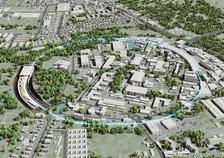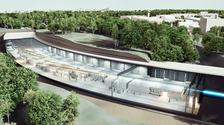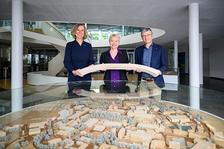Visualisation of the DESY campus in Hamburg. A blue marker runs in a circle around the site, representing the particle beam in the PETRA IV ring accelerator. The new experimental hall (partly underground) is visualised on the left. (Visualisation: DESY, Science Communication Lab)
The "Prioritisation procedure for extensive research infrastructures" of the Federal Ministry of Research, Technology and Space (BMFTR) ended today with a bang: Federal Research Minister Dorothee Bär announced that both projects submitted by DESY have been classified as research infrastructures of national importance. The X-ray light source PETRA IV and the neutrino telescope IceCube-Gen2 were thus attested high scientific excellence, innovation and transfer potential as well as well thought-out planning.
This paves the way for unrivalled research infrastructures worldwide: PETRA IV will enable researchers to analyze diverse structures, systems and processes on the nanoscale with unprecedented resolution and speed. The fields of application range from bio and quantum technologies, sustainable materials and new batteries to microelectronics and materials research. IceCube-Gen2, the international neutrino telescope, is the powerful upgrade of the IceCube detector that has been in operation at the South Pole since 2010. The upgraded detector, will be able to detect significantly more cosmic neutrinos and gain new insights into their sources, the Earth's atmosphere and the properties of Antarctic ice.
The BMFTR will now enter into talks with the participating institutions and federal states regarding the implementation of the projects.
Entering a new era of research with X-ray radiation
"We are delighted and greatly appreciate the fact that both of the future projects we submitted - PETRA IV and IceCube-Gen2 - have been prioritised by the Federal Ministry. The X-ray light source PETRA IV in particular offers enormous opportunities for cutting-edge research and innovation. It is also essential for European technology and data sovereignty. We will now build the best 4D X-ray microscope in the world," says Prof Dr Beate Heinemann, Chair of the DESY Board of Directors. "We look forward to discussions with the federal and state governments and the German Council of Science and Humanities."
"The PETRA IV X-ray light source enables the analysis of molecular structures, opening up new perspectives for fundamental research in the natural sciences," says Hamburg's First Mayor Dr Peter Tschentscher. "The PETRA IV project is of outstanding importance for research and development in key future topics. It is an important building block for the further development of DESY and Science City Hamburg Bahrenfeld which will make Germany internationally competitive as a centre of science." Maryam Blumenthal, Hamburg's Senator for Science, Research and Gender Equality, added: "PETRA IV sets new standards for what science can achieve for society. This future-oriented project will enable researchers in Hamburg to find solutions to the major challenges of our time using the world's most powerful synchrotron radiation source – whether in the design of sustainable technologies, the development of new medicines or research into new energy concepts. That is why we fully support this project and have already pledged the first steps in its financing. Being shortlisted by the Federal Ministry of Research is the next big step forward in realising this unique project. I congratulate everyone involved on this success!"
Setting standards –more independence
PETRA IV will be many times more brilliant, more precise and faster than the existing PETRA III facility and will also be able to "film" nanoscopic structural changes – hence the name 4D. This consolidates DESY's position as a world leader in X-ray light sources, increases Germany's attractiveness for excellent scientists and strengthens the innovative capacity of industry in Germany. Up to 20 per cent of data measuring time can be reserved for industrial applications. "Having such a brilliant X-ray light source in our own country means independence: it means not having to wait for experimental opportunities on other continents and having unrestricted, exclusive access to the data obtained," explains Beate Heinemann. The latter is particularly important for Europe in competition with USA and China.
Better light for research in Hamburg
A study by the Fraunhofer Institute for Systems and Innovation Research (ISI) concluded that the investment in PETRA IV will bring a direct additional economic benefit of seven billion euros. Further calculations show that the benefit rises to 24 billion euros if indirect effects from innovations made possible by the measurement data are taken into account. The core construction period, during which the existing PETRA III accelerator will be replaced by the new PETRA IV technology, is planned to be around 2.5 years. If funding is approved in good time, the light from PETRA IV will shine for the first time in Hamburg Bahrenfeld in 2032, enormously strengthening Science City Hamburg Bahrenfeld as a centre of innovation.
IceCube Gen2: The neutrino observatory at the South Pole
In addition to PETRA IV, DESY submitted a further project with a smaller budget (approx. 55 million euros for the German share) for the prioritisation process: The next generation of IceCube, a neutrino telescope that has been embedded in the ice of the South Pole since 2010 and is designed to record cosmic neutrinos. It achieved this for the first time in 2013. The research is being conducted by an international consortium, of which DESY is the second largest partner after the University of Wisconsin-Madison (USA). The IceCube Gen2 proposal has also been included in the shortlist that was published today. The upgrade will be able to detect approximately ten times more cosmic neutrinos per year than its predecessor. This means that IceCube Gen2 could explore the sources of cosmic neutrinos and the propagation of extremely high-energy cosmic radiation through the universe, among other issues.
(Partly from DESY News)









